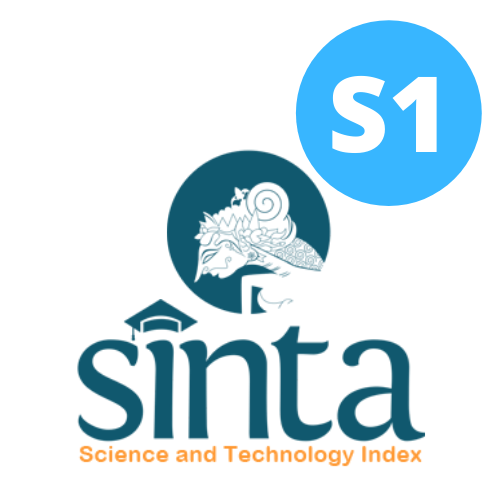The Association of Food Security, Parenting Patterns, and Nutritional Adequacy Levels with Stunting among Toddlers Aged 6–59 Months at the Dawe Community Health Center, Kudus
Hubungan Ketahanan Pangan, Pola Asuh, dan Tingkat Kecukupan Gizi dengan Kejadian Stunting Balita 6-59 Bulan di Puskesmas Dawe, Kabupaten Kudus

Downloads
Background: Stunting is a significant issue in Kudus District, with a 2023 prevalence of 15.7%, driven by factors like parenting patterns, food security, and nutritional intake. Despite being food-secure, the Dawe Health Center area has the third-highest stunting rate in Kudus Regency.
Objectives: Examine the correlations of family food security, nutritional adequacy levels, and parenting patterns with the incidence of stunting among toddlers at the Dawe Community Health Center.
Methods: This cross-sectional study sampled 86 mother-toddler pairs at the Dawe Community Health Center purposively. Data on stunting in toddlers and maternal height were assessed using anthropometric measurements. Information on general characteristics, parenting patterns, and household food security was gathered with interviews, questionnaires, and observations. Nutritional intake data were collected with 2×24-hour recall and the SQ-FFQ. Associations were analyzed using the chi-square test, Fisher's exact test, and multiple logistic regression analysis.
Results: The study found that respondents had good parenting patterns (58.1%) and were food-secure (74.4%). Energy (73.3%), zinc (91.9%), calcium (57%), iron (54.7%), and vitamin D (38.4%) intake were sufficient. In addition, all toddlers had sufficient protein and vitamin A. Bivariate test results showed that parenting patterns (p-value = 0.004), food security (p-value=0.006), energy adequacy (p-value<0.001), and calcium adequacy (p-value<0.001) were correlated with stunting. Multivariate test showed that energy adequacy (OR=7.7; p-value=0.003), calcium adequacy (OR=5.2; p-value=0.007), and parenting patterns (OR=5.3; p-value=0.006) were dominant factors associated with stunting.
Conclusions: The dominant factors influencing the occurence of stunting among toddlers at the Dawe Community Health Center were the levels of nutritional adequacy (energy, calcium) and parenting patterns.
Putri, A. R. Aspek Pola Asuh, Pola Makan, dan Pendapatan Keluarga pada Kejadian Stunting. Jurnal Kesehatan Tadulako 6, 7–12 (2020).
Putri, E. H. & Muniroh, L. The Relationship Between Characteristics of Toddlers, Socio-Economic, and Household Food Security with Stunting in Kampung 1001 Malam Surabaya, Surabaya. Media Gizi Kesmas 12, 21–29 (2023). DOI:10.20473/mgk.v12i1.2023.21-29.
Ekaputi, R. et al. Gambaran Asupan Gizi Mikro pada Balita Stunting di Desa Kalumbatan Totikum Selatan Kabupaten Banggai Tahun 2022. Jurnal Kesmas Untika Luwuk:Public Health Journal 1, 117–126 (2023).
Ernawati, A. Gambaran Penyebab Balita Stunting di Desa Lokus Stunting Kabupaten Pati. Jurnal Litbang: Media Informasi Penelitian, Pengembangan dan IPTEK 16, 77–94 (2020). DOI:10.33658/jl.v16i2.194.
Supariasa, I. D. N. & Purwaningsih, H. Faktor-Faktor yang Mempengaruhi Kejadian Stunting pada Balita di Kabupaten Malang. Karta Raharja 1, 55–64 (2019).
United Nations Children’s Fund (UNICEF), World Health Organization (WHO) & International Bank for Reconstruction and Development/The World Bank. Levels and Trends in Child Malnutrition. (UNICEF / WHO / World Bank Group Joint Child Malnutrition Estimates, New York, 2023).
Survei Kesehatan Indonesia (SKI) 2023 Dalam Angka. (Kementerian Kesehatan RI, Jakarta, 2024).
Priyono, P. Strategi Percepatan Penurunan Stunting Perdesaan (Studi Kasus Pendampingan Aksi Cegah Stunting di Desa Banyumundu, Kabupaten Pandeglang). Jurnal Good Governance 16, 149–174 (2020). DOI:10.32834/gg.v16i2.198.
Badan Kebijakan Pembangunan Kesehatan. Buku Saku Hasil Survei Status Gizi Indonesia (SSGI) 2022. (Kementerian Kesehatan RI, Jakarta, 2023).
Friska, E. & Andriani, H. Implementasi Kebijakan Percepatan Pencegahan Stunting pada Masa Pandemi COVID-19 di Kabupaten Kudus. Jurnal Kesehatan Masyarakat (JKM) 10, 258–292 (2022). DOI:10.14710/jkm.v10i5.35317.
Peraturan Bupati Kudus Nomor 10 Tahun 2023 Tentang Rencana Pembangunan Daerah Kabupaten Kudus Tahun 2024-2026. Bappeda Kabupaten Kudus (2023).
Badan Pangan Nasional. Peta Ketahanan Dan Kerentanan Pangan (Food Security Vulnerability Atlas) Tahun 2023. (Badan Pangan Nasional, Jakarta, Indonesia, 2024).
BPS Kabupaten Kudus. Hasil Pencacahan Lengkap Sensus Pertanian 2023 - Tahap 1 Kabupaten Kudus. (BPS Kabupaten Kudus, Kabupaten Kudus, 2023).
BPS Kabupaten Kudus. Kecamatan Dawe Dalam Angka 2023. (BPS Kabupaten Kudus, Kabupaten Kudus, 2023).
Mahudeh, Rohmah, N. & Adriani, S. W. Correlation Between History of Infectious Disease with Stunting in Toddler. Journal of Nursing Science Update (JNSU) 10, 193–200 (2023). DOI:10.21776/ub.jik.2022.010.02.15.
Aritonang, E. A., Margawati, A. & Dieny, F. F. Analisis Pengeluaran Pangan, Ketahanan Pangan dan Asupan Zat Gizi Anak Bawah Dua Tahun (Baduta) Sebagai Faktor Risiko Stunting. Journal of Nutrition College 9, 71–80 (2020). DOI:10.14710/jnc.v9i1.26584.
Zuhra, F., Sydaryati, E., Y, E. & Aritonang. Relationship Between Energy Intake and Diarrhea with Stunting Incidence in Children Age 0-59 Months in Lhokseumawe City. Budapest International Research and Critics Institute-Journal (BIRCI-Journal) 5, 30640–30645 (2022). DOI:10.33258/birci.v5i4.7223.
Siringoringo, E. T., Syauqy, A., Panunggal, B., Purwanti, R. & Widyastuti, N. Karakteristik Keluarga dan Tingkat Kecukupan Asupan Zat Gizi sebagai Faktor Risiko Kejadian Stunting Pada Baduta. Journal of Nutrition College 9, 54–62 (2020). DOI:10.14710/jnc.v9i1.26693.
Makatita, S. & Djuwita, R. Relationship of Mothers’ Parenting and Stunting in Toddlers Aged 12-36 Months in Bogor Regency, West Java Province, Indonesia in 2019. Indian J Public Health Res Dev 11, 1463–1469 (2020).
Femidio, M. & Muniroh, L. Perbedaan Pola Asuh dan Tingkat Kecukupan Zat Gizi pada Balita Stunting dan Non-Stunting di Wilayah Pesisir Kabupaten Probolinggo. Amerta Nutrition 4, 49–57 (2020). DOI:10.2473/amnt.v4i1.2020.49-57.
Yanti, N. D., Betriana, F. & Kartika, I. R. Faktor Penyebab Stunting pada Anak: Tinjauan Literatur. Real in Nursing Journal 3, 1–10 (2020).
Pangestu, N. K., Lystiarini, A. D. & Cahyanti, L. Faktor-Faktor yang Berhubungan dengan Kejadian Stunting di Kecamatan Dawe. Jourkep : Journal Keperawatan 2, 116–129 (2023).
Laksono, A. D., Sukoco, N. E. W., Rachmawati, T. & Wulandari, R. D. Factors Related to Stunting Incidence in Toddlers with Working Mothers in Indonesia. Int J Environ Res Public Health 19, 10654 (2022). DOI:10.3390/ijerph191710654.
Adelina, F. A., Widajanti, L. & Nugraheni, S. A. Hubungan Pengetahuan Gizi Ibu, Tingkat Konsumsi Gizi, Status Ketahanan Pangan Keluarga dengan Balita Stunting (Studi pada Balita Usia 24-59 Bulan Di Wilayah Kerja Puskesmas Duren Kabupaten Semarang). Jurnal Kesehatan Masyarakat (e-Journal) 6, 361–369 (2018).
Gunawan, D. C. D. & Septriana. Ketahanan Pangan Tingkat Rumah Tangga, Asupan Protein, dan Kejadian Stunting pada Anak Balita di Desa Planjan Kecamatan Saptosari Gunung Kidul. Jurnal Medika Respati 14, 63–68 (2019).
Mentari, T. S. Faktor yang Berhubungan dengan Pola Asuh Ibu Balita Stunting (Studi Kasus di Puskesmas Bandar I Kabupaten Batang). (Universitas Negeri Semarang, Semarang, 2019).
Susanti, A. Faktor-Faktor yang Berhubungan dengan Perilaku Ibu Balita pada Kejadian Stunting di Kecamatan Tirtomoyo, Wonogiri. (Universitas Diponegoro, Semarang, 2023).
Lemaking, V. B., Manimalai, M. & Djogo, H. M. A. Hubungan Pekerjaan Ayah, Pendidikan Ibu, Pola Asuh, dan Jumlah Anggota Keluarga dengan Kejadian Stunting pada Balita di Kecamatan Kupang Tengah, Kabupaten Kupang. Ilmu Gizi Indonesia 5, 123–132 (2022). DOI:10.35842/ilgi.v5i2.254.
Dinas Kesehatan Kabupaten Kudus. Profil Kesehatan Kabupaten Kudus Tahun 2022. (Dinas Kesehatan Kabupaten Kudus, Kabupaten Kudus, 2023).
SK Gubernur Jawa Tengah No. 561/57 Tahun 2023 Tentang Upah Minimum Pada 35 (Tiga Puluh Lima) Kabupaten/Kota Di Provinsi Jawa Tengah Tahun 2024. Bappeda Provinsi Jawa Tengah (Indonesia, 2023).
Atamou, L., Rahmadiyah, D. C., Hassan, H. & Setiawan, A. Analysis of the Determinants of Stunting among Children Aged below Five Years in Stunting Locus Villages in Indonesia. Healthcare 11, 810 (2023). DOI:10.3390/healthcare11060810.
Mahayati, N. M. D., Sriasih, N. G. K., Lindayani, K. & Dewi, I. N. Hubungan Riwayat Berat Badan Lahir Rendah dengan Stunting di Kecamatan Ubud Gianyar. Jurnal IMJ: Indonesia Midwifery Journal 3, 51–57 (2023).
Armawan, D. S., Hidayatuloh, H. S., Tresnasari, C. & Dharmmika, S. Scoping Review: Hubungan Prematur dengan Kejadian Stunting pada Anak Usia di Bawah 5 Tahun. Bandung Conference Series: Medical Science 2, 664–671 (2022). DOI:10.29313/bcsms.v2i1.1313.
Andari, W., Siswati, T. & Pramashanti, B. A. Tinggi Badan Ibu sebagai Faktor Risiko Stunting pada Anak Usia 24-59 Bulan di Kecamatan Pleret dan Kecamatan Pajangan, Kabupaten Bantul, Yogyakarta. Journal off Nutrition Collage 9, 235–240 (2020).
Kementerian Kesehatan RI. Permenkes RI No.2 Tahun 2020 Tentang Standar Antropometri Anak. Kementerian Kesehatan RI (Indonesia, 2020).
Nur Asih, R., Sunanto & Ekasari, T. Hubungan ASI Eksklusif dengan Kejadian Balita Stunting Usia 6-59 Bulan di Desa Jambekumbu. Medical Journal of Al-Qodri: Jurnal Keperawatan dan Kebidanan 8, 143–149 (2023).
Coates, J., Swindale, A. & Bilinsky, P. Household Food Insecurity Access Scale (HFIAS) for Measurement of Food Access: Indicator Guide: Version 3. www.fantaproject.org (2007).
Kementerian Kesehatan RI. Permenkes No. 28 Tahun 2019 Tentang Angka Kecukupan Gizi Yang Dianjurkan Untuk Masyarakat Indonesia. Kementerian Kesehatan RI (Indonesia, 2019).
Annisa, R. R., Pradigdo, S. F. & Dina, R. P. Hubungan Keragaman Pangan dengan Kecukupan Gizi dan Status Gizi Ibu Menyusui di Daerah Pertanian Kecamatan Karangreja Kabupaten Purbalingga. Jurnal Media Kesehatan Masyarakat Indonesia(MKMI) 20, 300–307 (2021). DOI:10.14710/mkmi.20.4.300-307.
Dahlan, M. S. Statistik Untuk Kedokteran Dan Kesehatan : Deskriptif, Bivariat, Dan Multivariat Dilengkapi Aplikasi Menggunakan SPSS Edisi 6. vol. 10 (Epidemiologi Indonesia, Jakarta, 2020).
Fithria et al. Energy, Protein and Calcium Intake are Determinants of Stunting in Toddler Aged 24 - 59 Months in Muna District. International Journal of Chemical and Biochemical Sciences 25, 727–733 (2024). DOI:10.62877/85-IJCBS-24-25-19-85.
Fikawati, S., Syafiq, A., Ririyanti, R. K. & Gemily, S. C. Energy and Protein Intakes are Associated with Stunting among Preschool Children in Central Jakarta, Indonesia: A Case-control Study. Malays J Nutr 27, 081–091 (2021). DOI:10.31246/mjn-2020-0074.
Chowdhury, R. et al. Vitamin-D Status and Neurodevelopment and Growth in Young North Indian Children: A Secondary Data Analysis. Nutr J 16, 1–8 (2017). DOI:10.1186/s12937-017-0285-y.
Wulandary, W. & Sudiarti, T. Nutrition Intake and Stunting of Under-Five Children in Bogor West Java, Indonesia. Journal of Food Sciences Nutrition 7, 1–6 (2021). DOI:10.24966/FSN-1076/100104.
Azmy, U. & Mundiastuti, L. Konsumsi Zat Gizi pada Balita Stunting dan Non-Stunting di Kabupaten Bangkalan. Amerta Nutrition 2, 292–298 (2018). DOI:10.2473/amnt.v2i3.2018.292-298.
Susindra, Y., Wahyuningsih, R. T. & Werdiharini, A. E. Korelasi Faktor Sosial Ekonomi dan Tingkat Konsumsi Zat Gizi dengan Kejadian Stunting. Jurnal Kesehatan 8, 124–133 (2020). DOI:10.25047/j-kes.v8i2.160.
Masitoh, S., Nurokhmah, S. & Ronoatmodjo, S. The Correlation Between Food Insecurity Level and Stunting in Indonesia. Jurnal Ilmu Kesehatan Masyarakat 13, 385–398 (2023). DOI:10.26553/jikm.2022.13.2.385-398.
Mariza, M. & Putriningtyas, N. D. Kejadian Stunting pada Balita: Studi Kasus di Desa Kebondalem, Kabupaten Pemalang. Indonesian Journal of Public Health and Nutrition 3, 204–214 (2023). DOI:10.15294/ijphn.v3i2.59678.
Rahayu, R. M., Pamungkasari, E. P. & Wekadigunawan, C. The Biopsychosocial Determinants of Stunting and Wasting in Children Aged 12-48 Months. Journal of Maternal and Child Health 03, 105–118 (2018). DOI:10.26911/thejmch.2018.03.02.03.
Lemaking, V. B., Manimalai, M. & Djogo, H. M. A. Hubungan Pekerjaan Ayah, Pendidikan Ibu, Pola Asuh, dan Jumlah Anggota Keluarga dengan Kejadian Stunting pada Balita di Kecamatan Kupang Tengah, Kabupaten Kupang. Ilmu Gizi Indonesia 5, 123–132 (2022). DOI:10.35842/ilgi.v5i2.254.
Wicaksono, R. A. et al. Risk Factors of Stunting in Indonesian Children Aged 1 to 60 Months. Paediatr Indones 61, 12–9 (2021). DOI:10.14238/pi61.1.2021.12-9.
Rahmawati, N. F., Fajar, N. A. & Idris, H. Faktor Sosial, Ekonomi, dan Pemanfaatan Posyandu dengan Kejadian Stunting Balita Keluarga Miskin Penerima PKH di Palembang. Jurnal Gizi Klinik Indonesia 17, 23–33 (2020). DOI:10.22146/ijcn.49696.
Maulidah, W. B., Rohmawati, N. & Sulistiyani, S. Faktor yang Berhubungan dengan Kejadian Stunting pada Balita di Desa Panduman Kecamatan Jelbuk Kabupaten Jember. Ilmu Gizi Indonesia 2, 89–100 (2019). DOI:10.35842/ilgi.v2i2.87.
Damayanti, R. A., Muniroh, L. & Farapti, F. Perbedaan Tingkat Kecukupan Zat Gizi dan Riwayat Pemberian ASI Eksklusif pada Balita Stunting dan Non Stunting. Media Gizi Indonesia 11, 61–69 (2017). DOI:10.20473/mgi.v11i1.61-69.
Nelly SD Situmeang, Etti Sudaryati & Jumirah. Correlation of Parenting and Nutrient Intake with Stunting in Children 24-59 Months. Britain International of Exact Sciences (BIoEx) Journal 2, 280–285 (2020). DOI:10.33258/bioex.v2i1.147.
Rizky Maulidiana, A. & Sutjiati, E. Low Intake of Essential Amino Acids and Other Risk Factors of Stunting among Under-Five Children in Malang City, East Java, Indonesia. J Public Health Res 10, (2021). DOI:10.4081/jphr.2021.2161.
Anshori, L. Moh., Fikawati, S. & Sutrisna, B. Relationship Energy and Protein Intake with the Incidence of Stunting Among Toddler Aged (25-60 Months) in Mangkung Village, District of Central Lombok. Indian J Public Health Res Dev 11, 1593–1598 (2020). DOI:10.37506/ijphrd.v11i3.1858.
Jayusman, D. D. K., Aritonang, E. Y. & Lubis, Z. Comparison of Calcium and Iron Intake of Stunting and Non-Stunting Toddlers in Langkat Regency. International Journal of Research and Review (ijrrjournal.com) 8, 501–508 (2021).
Duan, Y. et al. Association between Dairy Intake and Linear Growth in Chinese Pre-School Children. Nutrients 12, 2576 (2020). DOI:10.3390/nu12092576.
Tang, X. et al. The Effect of Risk Accumulation on Childhood Stunting: A Matched Case-Control Study in China. Front Pediatr 10, (2022). DOI:10.3389/fped.2022.816870.
Sihite, N. W., Nazarena, Y., Ariska, F. & Terati, T. Analisis Ketahanan Pangan dan Karakteristik Rumah Tangga dengan Kejadian Stunting. Jurnal Kesehatan Manarang 7, 59–66 (2021). DOI:10.33490/jkm.v7iKhusus.550.
Safitri, C. A. & Susila Nindya, T. Hubungan Ketahanan Pangan dan Penyakit Diare dengan Stunting pada Balita 13-48 Bulan di Kelurahan Manyar Sabrangan, Surabaya. Amerta Nutrition 1, 52–33 (2017). DOI:10.2473/amnt.v1i2.2017.52-61.
Copyright (c) 2025 Amerta Nutrition

This work is licensed under a Creative Commons Attribution-ShareAlike 4.0 International License.
AMERTA NUTR by Unair is licensed under a Creative Commons Attribution-ShareAlike 4.0 International License.
1. The journal allows the author to hold the copyright of the article without restrictions.
2. The journal allows the author(s) to retain publishing rights without restrictions
3. The legal formal aspect of journal publication accessibility refers to Creative Commons Attribution Share-Alike (CC BY-SA).
4. The Creative Commons Attribution Share-Alike (CC BY-SA) license allows re-distribution and re-use of a licensed work on the conditions that the creator is appropriately credited and that any derivative work is made available under "the same, similar or a compatible license”. Other than the conditions mentioned above, the editorial board is not responsible for copyright violation.












































